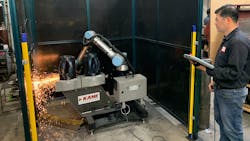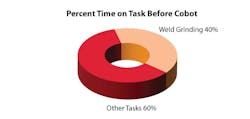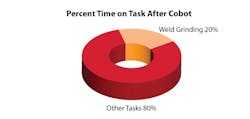Cobots Double Weld Grinding Efficiency Without Replacing Human Know-How
Many manufacturing functions are becoming fully automated, thanks to engineers designing advanced industrial robots that make processes safer and more efficient. But will cobots replace manufacturing jobs?
The short answer is definitely “no.” Collaborative robotic arms that replace human hands for repetitive, precision tasks are becoming more commonplace in small- and medium-sized manufacturing operations. But cobots are not taking the place of hmans. They are freeing up skilled workers to perform higher-order tasks and learn new skills, bringing added efficiency and safety to engineering and manufacturing processes.
Cobots have been used for decades in manufacturing environments to handle simple, repetitive manual processes like picking, palletizing and machine tending. But as robotics technologies advance, cobots are capable of more nuanced low-volume, high-mix material removal tasks such as weld grinding, sanding and finishing that require stamina, precision and skill.
Does that mean cobots will replace humans on the manufacturing floor? Not anytime soon. Cobots specializing in advanced material removal help are helping engineers complete projects more quickly, safely and efficiently while filling a labor gap for hard-to-fill positions. Yet, unlike traditional industrial automation that performs end-to-end processes without human intervention, cobots require humans to program, monitor and assist the technology to complete projects.
READ MORE: Automate 2023 Showcases Process Automation: Coordinators, Orchestrators & Differentiators
The Challenge of Weld Grinding
Weld grinding is a good example of cobots aiding human technicians. Welding, a fundamental process in many manufacturing, construction and other industries, often leaves behind unwanted weld seams called “weld beads.” Removing these weld beads through grinding is essential to ensure the final product's quality and appearance. Traditionally, weld grinding has been a manual task involving skilled operators who use handheld grinders, abrasives and protective gear.
However, manual weld grinding presents several challenges. It is labor-intensive and physically demanding, often leading to operator fatigue, musculoskeletal disorders and reduced productivity due to repetitive motion injuries. Human operators may also struggle to maintain consistent grinding quality, resulting in unwanted variations. Additionally, grinding produces hazardous dust, noise and sparks that can pose safety risks to human operators. And, because of the demanding nature of weld grinding, there is often a high turnover rate for these positions, leading to job vacancies and recruitment challenges.
No Breaks, No Mistakes: Cobots as the Solution
Cobots, designed to work alongside human operators, offer a solution to these challenges. Cobots enhance the weld-grinding process by:
- Increasing efficiency. Cobots equipped with end-of-arm grinding tools work continuously without fatigue, significantly reducing cycle times and increasing production efficiency.
- Ensuring quality. Cobots are programmed to maintain a consistent and precise grinding force and speed, ensuring uniform weld-bead removal and improving product quality.
- Improving safety. Cobots typically have built-in safety features, such as sensors and vision systems that allow them to stop or slow down when a human operator enters their workspace, reducing the risk of accidents. Reducing turnover. By automating tedious and physically demanding tasks, cobots can help reduce labor turnover rates and alleviate the shortage of skilled workers for weld-grinding positions.
A Study in Collaborative Weld Grinding
Summit Casing Equipment, an oil and gas equipment manufacturer, was having difficulty hiring and retaining people to grind welds on their centralizers, the metal pieces in an oil well pipe that center well casing in a borehole. The manual weld-grinding work involved long hours, protective eyewear and clothing, and awkward, repetitive motions that caused technicians arm pain and fatigue. Weld grinders tended to quit soon after hiring or were promoted to more advanced positions. Thus, keeping technicians in weld-grinding roles was a challenge. Grinding was the most time-consuming for those with multiple tasks, delaying other work. Productivity suffered.
Summit reached out to Kane Robotics, a cobot manufacturer specializing in material removal. Kane engineers modified their GRIT cobot solution to meet Summit’s weld-grinding needs. Using a standard robotic arm mounted to a mobile table with a 110V electrical connection, Kane equipped the solution with an end-of-arm tool purpose-built for weld grinding. Kane engineers changed the position of their standard mounting to load parts more easily and redesigned the attachments to hold Summit’s unique centralizers in place.
READ MORE: 5 Ways Cobots Are Boosting the Efficiency of Automotive Manufacturing Processes
Kane engineers preprogrammed GRIT’s force, speed, area and duration to grind the centralizer welds to Summit’s specifications. They quickly and easily taught human operators to configure the cobot, load the centralizers onto it, monitor the grinding and offload the finished product.
With the GRIT solution, Summit grinds welds twice as quickly, doubling the number of centralizers their teams can process per shift. Efficiency improved, as cobots did not require breaks nor suffer injuries and output quality is consistent.
Cobot grinding caused less wear-and-tear on Summit’s people—and its parts. The grinding discs last longer because the cobot applies more uniform pressure, angle and speed, causing less damage than a human’s variable movements.
From May-September 2023, Summit’s cobots ground nearly 250 thousand welds on 60,000 centralizers. In addition to doubling product output per shift, the company expects to save over $10,000 per cobot each year simply by extending the lifespan of each $7 grinding disc.
With the more efficient cobot solution, the weld-grinding process requires two fewer technicians who could focus on other tasks, further improving efficiency in the overall manufacturing process.
Importantly, technicians on the shop floor were enthusiastic about adopting the GRIT cobot solution to manage the unpopular grinding tasks. Rather than viewing automation as a threat, workers saw GRIT improve their work—and their satisfaction.
READ MORE: What Makes a Good Robot Joint for Cobots?
Cobots: A Design for the Future
Cobots not only make material removal easier and safer, but they also enable human technicians to retain their significance in the manufacturing process while improving quality of life in the workplace.
And contrary to popular belief, cobots may encourage hiring. A recent study showed that U.S. companies that adopted automation were more likely to increase their headcount. Because automation made them more competitive and lowered costs, these companies could grow their businesses—and hire more employees.
As engineers continue to improve cobot functionality, capability and precision, the role of humans in relation to cobots will evolve. However, by definition, cobots will continue to work with their human operators to improve manufacturing processes—collaboratively.
John Spruce has spent more than 25 years as an executive and entrepreneur leading diverse teams in the aerospace and defense industries. He is currently CEO of Kane Robotics.
About the Author
John Spruce
CEO, Kane Robotics
John Spruce has spent more than 25 years as an executive and entrepreneur leading diverse teams in the aerospace and defense industries. His experience ranges from complex engineering and manufacturing projects to intellectual property development and licensing. He is currently CEO of Kane Robotics, developer of the first easy-to-use collaborative robotic systems dedicated to assisting manufacturers with the time-consuming, hazardous and repetitive sanding, grinding, and finishing of various materials.




